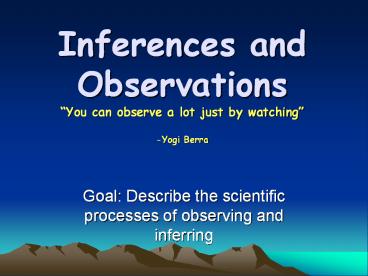Inferences and Observations - PowerPoint PPT Presentation
Title:
Inferences and Observations
Description:
Inferences and Observations You can observe a lot just by watching -Yogi Berra Goal: Describe the scientific processes of observing and inferring – PowerPoint PPT presentation
Number of Views:397
Avg rating:3.0/5.0
Title: Inferences and Observations
1
Inferences and ObservationsYou can observe a
lot just by watching-Yogi Berra
- Goal Describe the scientific processes of
observing and inferring
2
(No Transcript)
3
Observations
- Observations use one or more of your senses
(sight, hearing, smell, taste and touch) to
gather information about the world. - Accurate Observation An exact report of what
your senses tell you. - Objective Observation Avoids opinion, or bias,
based on specific points of view. - Qualitative Descriptions that do not use numbers
(colors, smell, taste, textures, sounds). - Quantitative Observations that use numbers
(counting, measuring, weighing).
4
Observations
- Tips for making observations
- Use your five sensesi.e. qualitative
- Whenever possible, count or use measuring tools
to make quantitative observations. - Estimate if no tools are available!
- Make sure that your observations are accurate and
objective!
5
Observations
- Do the following describe qualitative or
quantitative observations? - 1- The bird has 2 wings.
- 2- Mrs. Ing has Blue eyes.
- 3- The flower has 7 petals.
- 4- The fish feels slimy.
- 5- The sloth weighs 217lbs.
- 6- The red flower has 2 green leaves on its stem.
- 7- The egg smells.
- 8- The road is long.
6
Observations
- How could you make the following example into a
quantitative one? - The fish is smelly.
- Ex Add a scale, such as 1-5, 5 being the worst.
- What would be wrong with an observation such as
the burning bag smelled nasty? - Nasty is a relative term. What is nasty to one,
is not to another. In other words. avoid
opinions! - To correct this, we would change it to The
burning bag smelled like rotten eggs
7
Observations
Take a minute to list some observations of the
given picture.
8
(No Transcript)
9
Observations
10
Observations
- List any observations that you can for each
demonstration - Candle in air
- Match in tube
- Use both qualitative, and quantitative
observations.
11
Inferences
- Infering is the explaining or interpreting of an
observation or statement. - Reasonable (logical) Inference One that makes
sense, given that the person knows about the
topic. - Unreasonable Inference One that concludes too
much from the evidence. - Inferences are based on past experiences and
prior knowledge. They are often changed when new
observations are made. - Inferences help to explain our observations!
12
Inferences
- Tips for making an inference
- Make your inference based on accurate qualitative
or quantitative observations. - Combine your observations with knowledge or
experience to make your inference. - Try to make more than one logical inference from
the same observation. - Decide what new information you need to show
whether your inferences are true. - Gather more information. If necessary.
- Be prepared to modify, reject or revise your
inference.
13
Inferences
- Examples The grass on the schools front lawn
is wet. - Possible Inferences
- It rained
- The sprinkler was on
- There is dew on the grass from the morning
- A dog urinated on the grass
- All of these inferences could possibly explain
why the grass is wet. They are all based on prior
experiences. We have all seen rain, sprinklers,
dew, the dog doing its thing
14
Inferences
- What inferences could be made from the following
observation - The school fire alarm is going off.
15
Inferences
What are some inferences that can be made about
this picture?
16
Inferences
List some inferences that could be made about
this picture.
17
Inferences
- What inferences could be made about the two
demonstrations? - Candle
- Tube
18
- Using the picture given, make 5 observations and
5 inferences. Write these on a separate sheet of
paper.
19
(No Transcript)































